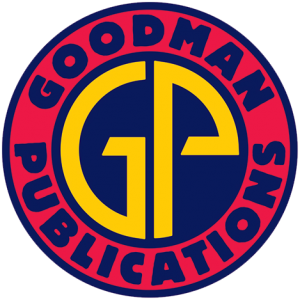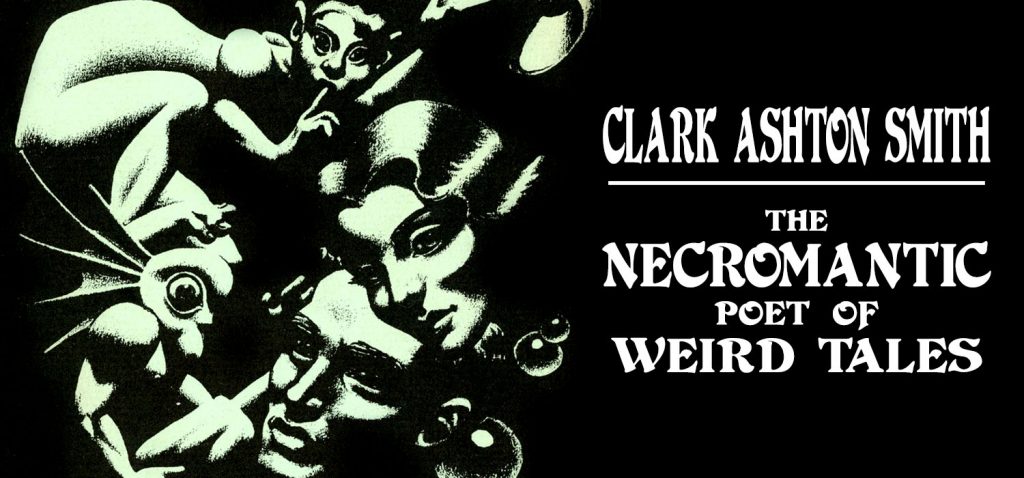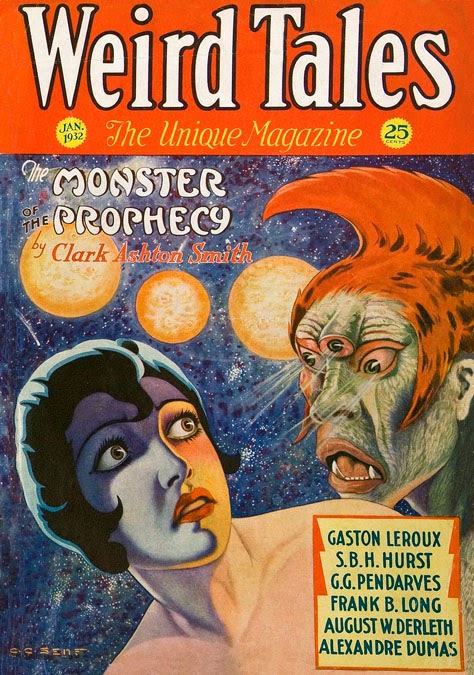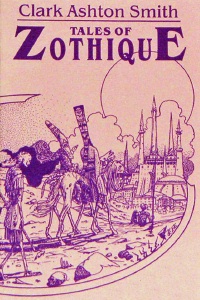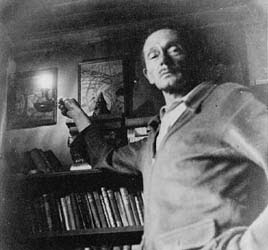Clark Ashton Smith: The Necromantic Poet of Weird Tales
by Ryan Harvey
During the halcyon days of Weird Tales in the 1920s and ‘30s, three writers became so closely linked with the magazine, and so closely linked to each other through their exchange of letters and ideas, that they’re known today as the “Weird Tales Triumvirate”: H. P. Lovecraft, Robert E. Howard, and Clark Ashton Smith.
Lovecraft and Howard have achieved posthumous pop culture superstardom. Howard’s Conan the Barbarian is a household name, and Cthulhu, Lovecraft’s primordial god of madness, makes cameos on South Park and in late-night talk show monologues.
Smith doesn’t have the same ubiquity. A talented poet, painter, and sculptor, Smith made his biggest impact with his macabre fantasy and science-fiction short stories. But his unique style and themes could never make him widely popular. One of his greatest admirers, Ray Bradbury, said that Smith was “a special writer for special tastes; his fame was lonely … Every writer is special in some way, and those who are more than ordinarily special are either damned or lost along the way.” Thankfully, Clark Ashton Smith has never been fully lost. Many modern fantasy writers list him as an influence, and a handful of publishers keep his stories in print.
Clark Ashton Smith was born in 1893 in Long Valley, California and spent most of his life in Auburn, a town in Gold Rush country. He was mostly self-educated, reading straight through the dictionary for pleasure in his parents’ cabin. He started writing when he was eleven, crafting tales in the style of the Arabian Nights. He was primarily pulled toward poetry—he had a taste for florid and strange words, the more archaic the better.
Smith published his first poetry book, The Star-Treader and Others, when he was nineteen. At the time, he was part of the Bohemian arts scenes in Carmel-by-the-Sea, to which he was introduced by George Sterling, a leading West Coat poet and one of Smith’s idols. But the arts scene faded, Smith suffered health problems, and the promise of career as a renowned author of fantastic verse never emerged.
At the suggestion of H. P. Lovecraft, Smith started writing stories for the pulp market in the mid-twenties. Although he’d prefer to stay with poetry, he needed money to support his ailing parents. During a short stretch of years from 1929 to 1935 Smith turned out more than a hundred stories for Weird Tales and the few other pulps with a taste for his prose Arabesques.
The stories from Smith’s peak period are immersed in images of death and its accoutrements: crypts, tombs, shrouds, liches, necropolises. Titles like “The Empire of the Necromancers” and “The Charnel God” show Smith’s adoration of the dead and the ancient. Remorse, loss, and dreams of forgotten ages fill up these stories, adorned with an appropriate poetic style:
“Then, into the hall, there filed an array of tall mummies, clad in royal cerements of purple and scarlet, and wearing gold crowns on their withered craniums. And after them, like servitors, came gigantic skeletons who wore loin-cloths of nacarat orange and about whose upper skulls, from brow to crown, live serpents of banded saffron and ebon had wrapped themselves for headdresses.” (“The Dark Eidolon”)
Rather than using continuing characters as many pulp writers did, Smith used continuing locations. The three that inspired his best work were Averoigne, Hyperborea, and Zothique. Averoigne is a fictional region in medieval France with vampire-haunted ruins, gargoyles leaping from city cathedral perches, and priests who worship ancient evil deities. Hyperborea is Greenland in a forgotten ice-free epoch when it was a land of sorcery and sardonic, mordant humor that often flew over readers’ (and editors’) heads.
Zothique, a classic “Dying Earth” setting, was where Smith found his greatest inspiration and set the largest number of stories. Zothique is “the last continent, beneath a dim sun and sad heavens where the stars come out in terrible brightness before eventide.” Science is forgotten, and necromancy reigns. Among the decadent and regretful residents of Zothique, Smith was best able to exercise his talent for beautiful morbidity and strangeness.
Smith also explored writing planetary adventures, which opened up a second market for him at the magazine Wonder Stories. Even with the presence of super-science, Smith’s science-fiction stories are as lonesome and grotesque as his fantasies, with “The God of the Asteroid,” “The Demon of the Flower,” and “The Dweller in the Depths” as stand-outs. These works display one of Smith’s most impressive talents: blurring the lines of established genres. A story like “The Vaults of Yoh-Vombis” melds horror, science fiction, and fantasy in a thick stew. This alchemical combination is the essence of the “weird tale,” and few practiced it in purer form than Clark Ashton Smith.
Story was rarely Smith’s primary concern. Sensation came first—the hum of words and phrases exciting the senses to uplift readers from reality. Many of the stories told of people, often poets and writers, who are drawn from reality into realms lovely and lethal: “The Monster of the Prophecy,” “Genius Loci,” “The Chain of Aforgomon.” Perhaps Smith felt himself a displaced person as well: the poet trapped in a provincial town that had little appreciation for his wild conjurations.
After his father and mother died in the mid-‘30s, Smith no longer needed the support money from pulp sales. The early deaths of both Robert E. Howard and H. P. Lovecraft stung him as well, and Smith’s writing output almost ceased after 1937. He released only a smattering of stories during the rest of his life, and died in his sleep in 1961. His penultimate story, “The Symposium of the Gorgon,” concludes with a simple and fitting goodbye for a poet: “I wish that Pegasus would return.”
